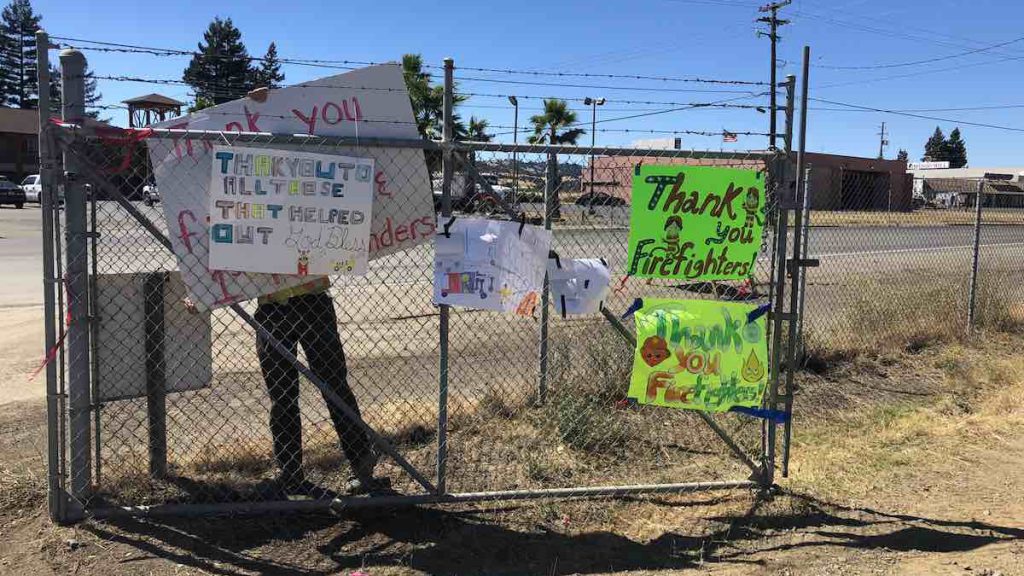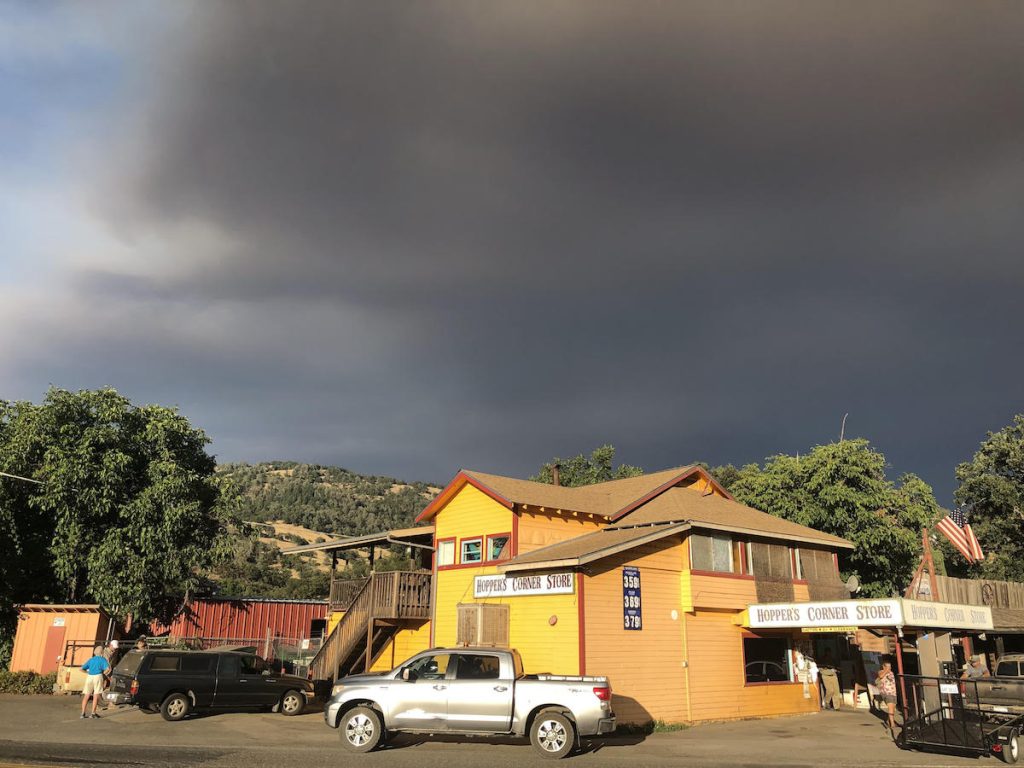
Community signs thanking firefighters outside the Mendocino Complex Fire Incident Command in Ukiah, CA. Photo: Kate Maxwell
How journalists can help communities prepare for disasters
What does your community need to know?
Meeting your audience where they are is essential during emergencies, since people often do not have time to process vital information at the same speed they would when it’s not an emergency. People need accessible, accurate info in life or death situations, often with limited connectivity. Providing your audience with useful information to navigate emergencies will help build relationships and trust for other coverage, and can be updated as new needs or circumstances emerge. Long term, providing useful coverage about disasters can not only bring in new audiences and collaboration opportunities, but also potentially be a source of new revenue through building ongoing relationships.
Not all newsrooms have the capacity to cover breaking news when disaster strikes — but if you are considering how to prepare as an individual reporter or newsroom leader, there are many parallel strategies that not only can help your community prepare, but can be integrated into your ongoing coverage, making your outlet and community more resilient.
It can also make coverage during a disaster easier if you create resources like easily referenceable evergreen information guides or local context for your audience ahead of time. This will reduce the amount of new information and learning curve for staff during times of confusion and panic, and create more efficient internal workflows during fast-changing situations.
This reporting can include immediately actionable information, such as where and how to sign up for the relevant emergency notifications in your area, and what a “declaration of emergency” means. But you should also consider broader reporting, such as places to connect with resources or volunteer opportunities, the development of your local community emergency response plans, or how agencies are responding – or not – to the impacts of climate change in your region.
Many of the same types of things that will be helpful to prepare as a newsroom or individual reporter are also helpful for your audience to learn about as well. These might include building a go bag and knowing evacuation routes, being up to date on insurance policies and safety training, signing up for emergency alerts and understanding different levels of warnings, learning about the history of previous disasters in the region and local active mutual aid groups.

As you’re developing an emergency source list and maps for your newsroom, talk to official sources and identify relevant data as a way to find existing issues your community might be facing when a disaster hits. Talking with community members and subject matter experts will help you understand what questions and concerns they may have. You may want to consider conducting community listening sessions or surveys to see what questions your readers have about how to prepare or respond to a disaster to inform coverage and determine immediate needs and preferred platforms for your communities.
Many local jurisdictions may not have a dedicated emergency manager, but they will have a local emergency plan. That’s one way to understand the official hazards, risks, potential emergencies, and response strategies for your area. These plans are periodically reviewed and updated in a public process with public comment, providing another way to help your audience understand and engage with local emergency response.
Other vital roles that local reporters can play for their communities include learning how to understand and clearly explain complex data, precise technical terms, and the emergency response system overall. Beginning to track more complex topics such as budgets or grants used for contracts for emergency preparedness, or policies around opening emergency shelters or disaster insurance coverage, can open up opportunities for more enterprise, accountability and investigative coverage before and after disasters. Starting this kind of coverage in advance will also help identifying useful data tools or future special projects.
One common theme that often emerges in the midst of a disaster is that people need help navigating the various official information sources in order to know how to apply or understand them. Figuring out whether the road to the shelter is open or how to sign up for text alerts or understand warnings. And how to track deadlines, eligibility, and apply for emergency food benefits is often opaque and complex even during calmer times.

Historically underserved communities are often already left out or ineligible for official programs. They may also be less able to connect to official communication channels during emergencies or left out of translations of that vital information. They are also not often considered in other types of accessibility, and more likely to suffer ongoing impacts after disasters. Identifying what ways your newsroom can reach, connect with, and help different communities prepare in advance will improve your coverage and diversity of sources overall, and help you identify different information needs that could arise. This could range from unhoused communities caught outside in storms to non-English speakers excluded from emergency alerts, for which your outlet can play an essential role in facilitating access to crucial and potentially life-saving information.
Here are some topics to consider, including examples
Explainers or enterprise coverage
- History of previous emergencies and disaster response in the area, including FEMA recovery. Examples: Lake County News’ “What the extreme fire seasons of 1910 and 2020 tell us“, Mendocino Voice’s “Did you hear last week’s tsunami warning? NWS explains”
- Information about local emergency response plans and how to be involved. Example: YubaNet’s “Placer County plans innovative model to manage emergency response“
- Information from local or relevant experts about the impacts of larger issues such as climate change, Covid-19 on potential disasters. Examples: KQED’s “This winter’s floods could be ‘only a taste of the megafloods to come,” “Epicenter NYC’s “Food insecurity, exacerbated by the pandemic, continues,”
- Examination of local data related to disasters, resource inequality, including data tools such as air quality maps, census tracts, and more. Examples: OPB’s “FEMA denied most Oregonian’s requests,” The Conversations “How inequality shapes your experience of a heat wave“
- Information about existing community groups and emergency resources, trainings such as CERT, etc. or groups addressing inequality/providing mutual aid. Examples: Epicenter NYC’s “SNAP Hacks: How to use your EBT card,” Mendocino Voice’s “When help can’t come for days“
- How similar communities are preparing for disasters or have implemented solutions to address community preparedness and resiliency. Example: Jefferson Public Radio’s “Medford launches interactive map to help with next disaster“
Evergreen guides to help prepare your community
- Relevant disaster and emergency terminology
- Disaster specific information, i.e. “red flag warning” which is often standardized across state or federal agencies. Examples: Southerly disaster glossary, CapRadio’s “What the heck is a red flag warning”
- Locally relevant information, such as evacuation zones, alert levels, public health. Example: Outlier’s Detroiter’s Guide to the Air We Breathe
- Information about emergency info sources: How to receive emergency notifications & stay informed. Examples: Mendocino Voice’s wildfire and winter storm guides, “PG&E reminds consumers to update contact information for planned outage alerts”
- Data if easily available/depending on tech, i.e. map of current fires in state. Example: Lost Coast Outpost’s Quakebot
- Guidance about how to prepare for disasters and the resources available for different communities. Example: Southerly’s “Make copies of everything in case of a hurricane,”
- Information about what to do in specific emergency situations relevant to your coverage area. Example: Berkeleyside’s “Protecting yourself from wildfire smoke in Berkeley“
- Seasonal guides to weather-related preparation. Examples: YubaNet’s “How to winterize your pipes for winter,” “Getting ready for peak fire season” series; Texas Tribune’s “How to prepare for this year’s storm season,” Berkeleyside’s Wildfire Guide
Additional actions to consider
- Create reusable templates or content, info boxes, data tools, or other frequently repeated or referenced information for ongoing coverage on a specific topic or during an emergency. Examples: YubaNet’s “Fire News” landing page, Cabin Radio’s wildfire map
- Interview, listen, and survey: talk with local community groups, emergency response officials, and your readers about their questions and information needs. Examples: Listening Post’s Collective Playbook; The Mendocino Voice’s emergency info survey and results
- Consider what partnerships and collaborations might be useful for sharing existing preparedness information to allow for resources to be allocated for more original reporting. Example: Mendocino Voice “Six steps to prepare from the Fire Safe Council“
- Identify potential tools or data sets that are useful to understand how disaster might impact your community. Example: Muckrock Wildfire smoke project
- Consider what ways you are reaching different audiences and if there are products or feedback loops you want to explore now, such as SMS messages or newsletters. Examples: SMS disaster coverage from Honolulu Civil Beat and Texas Tribune, The New Tropic: What we learned from Irma
- Create an explainer for your audience about how you intend to cover disasters and how they can reach you. Examples: Honolulu Civil Beat’s “Our Maui coverage is just beginning“

Comments